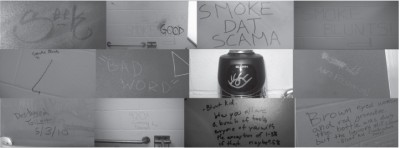Spencer Fox ’11
Staff Writer
Vandalism has become a problem at Staples. Bathroom walls display a wide variety of phrases, words and illustrations from the bizarre to the vulgar. Inklings interviewed someone who was caught and those who cleaned up his tags.

Staples’ Zak Rose ’10 was found guilty on multiple accounts of graffiti. He did not draw swastikas, nor did he write lewd comments about how “skewlsux” or “smoking weed everyday.” He drew ducks.
Throughout the school day, there is a steady influx of Staples students going in and out of the bathrooms. Some do just what the rooms are designed for, others splash an awakening surge of water onto their faces and others touch up their mascara and eyeliner. Some, however, use the bathrooms for what they claim is a more “artistic” and rebellious reason: to write on the walls.
Graffiti has certainly made its mark on the school. The most striking aspect of this subculture of Staples is its variety and seemingly fearless nature, ranging from rude to even racist remarks, from childish drawings to elaborate designs.
Regardless of the content, graffiti doesn’t seem to be going anywhere. While its prevalence around the school seems to be a constant, the views on its existence seem to be more than varied.
Here is an interview with Zak Rose on the topic itself:
Inklings: Do you think what you did was creative or destructive?
Zak Rose: Creative, because I knew that when people saw ducks in the bathroom they would just be confused, and think it was funny and hopefully not take it the wrong way. I just kind of thought that I was making the bathroom better. After a long, hard day in class, I think everyone would like to see a duck.
I: Why ducks?
ZR: That’s exactly what I was going for. I thought people would look at it and think, “Why a duck?” I think people should try and find a deeper meaning behind what they see.
I: How do you feel in general about graffiti in schools?
ZR: I don’t think that graffiti is bad. I don’t approve of it really, because most of it is either nonsense or offensive, but if it’s funny or beautiful then I approve. But there isn’t a lot of beautiful graffiti in our school.
I: Do you think it’s fair to view graffiti as a nuisance?
ZR: No, because some of it is artistic and a way of expressing something they feel other people should see.
I: Do you think it’s a form of expression or a form of pollution?
ZR: I think it’s a form of expression because most graffiti has a big meaning behind it, and the only way people are going to see this big meaning is if someone puts it in a place where people commonly go to, which is why graffiti artists put their tags in very visible places.
People aren’t always going to listen to you if you have something to say, but if you put it right in front of their face, they don’t have that much of an option.
I: Why do you think graffiti is associated with things like gangs, violence, and other bad imagery?
ZR: Because there are people with bad intentions who use graffiti to their advantage.
I: What do you think about the idea that you shouldn’t be putting ducks on walls that are being paid for with taxpayer’s money?
ZR: I don’t think putting ducks on a wall lowers the wall’s ability to do what it already does. It just stands there blank with nothing on it except for other graffiti that will end up there inevitably.
I: In your ideal universe, what would the general consensus of graffiti be?
ZR: If it’s offensive, then it should be viewed negatively, but if it is clearly not [offensive], then I think that what people should do is think beyond what they see, and try to understand why somebody would do it.
After the interview with Rose, an interview with some whose job is affected by graffiti seemed only logical. The following is an interview with custodian Elsie Colderón.
Inklings: How do you feel about the graffiti in the school bathrooms?
Elsie Colderón: It’s a shame because Staples is such a nice school, and [students] should appreciate what they have instead of ruining it.
I: Have you ever been offended by a piece of graffiti found around the school?
EC: I’ve been genuinely offended by a lot of the pieces of graffiti.
I: What is the process that you use to remove the graffiti?
EC: If it’s really offensive, you have to report it to the head custodian and then to the Assistant Principal. Then, they take pictures, and then you need to get approval to remove it. After the approval, you have a chemical that removes the graffiti [if it was written on the wall.] Cuts are hard to remove.
The following is an interview with custodian Linda Balde.
Inklings: How do you feel about the graffiti on the bathroom walls?
Linda Balde: It doesn’t bother me. I don’t try to put my attention on these things. You can’t change anybody, you can only change yourself.
I: Where do you see the graffiti?
LB: It’s only in the boys’ bathroom. The girls’ bathroom is fine.
I: Do you think graffiti is disrespectful?
LB: It is so disrespectful. You’re destroying something that other people are paying money for. It’s disrespectful to custodians; it’s disrespectful to other students.














































